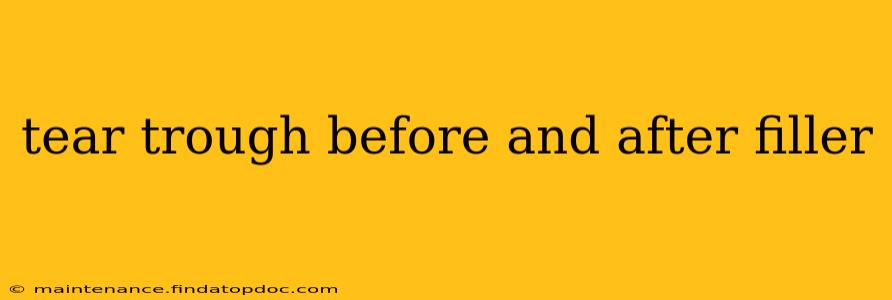Tear troughs, those dark, hollowed-out areas under the eyes, are a common concern for many. They can make you look older and more tired than you feel. Fortunately, dermal fillers offer a minimally invasive solution to rejuvenate this delicate area. This guide explores tear trough filler before and after results, addressing common questions and concerns.
What are Tear Troughs?
Tear troughs are the natural indentations or hollows under the eyes, located between the lower eyelid and the cheek. As we age, the fat pads in this area naturally diminish, resulting in a more pronounced hollow appearance. This loss of volume, coupled with thinning skin and loss of collagen and elastin, contributes to the development of dark circles and a tired look. Genetics also play a role; some individuals are naturally predisposed to more prominent tear troughs.
Tear Trough Filler: Before and After Photos – What to Expect
Before-and-after photos showcasing tear trough filler results are readily available online, and they generally illustrate a significant improvement in the appearance of the under-eye area. However, it’s crucial to remember that individual results vary depending on several factors including:
- Severity of tear troughs: Individuals with less severe hollows will typically see more subtle but still noticeable improvements. Those with deeper troughs may require more filler for optimal results.
- Skin type and quality: Thinner, more delicate skin may show results more dramatically, while thicker skin might require a slightly different approach.
- Filler type and placement: The type of filler used and the skill of the injector directly impact the outcome. An experienced injector will precisely place the filler to achieve natural-looking results, avoiding overfilling or complications.
- Age and overall facial structure: The overall aging process and individual facial features influence the final result.
Before the procedure: You'll have a consultation with your injector to discuss your goals, medical history, and assess your suitability for treatment. They will examine your tear troughs, take photos, and recommend the most appropriate filler and injection technique.
After the procedure: Immediately after treatment, you might experience some mild swelling, bruising, or redness. This usually subsides within a few days to a week. The full effects of the filler are usually visible after a couple of weeks, once the swelling has completely resolved.
What Type of Filler is Used for Tear Troughs?
Hyaluronic acid (HA) fillers are the most commonly used for tear trough correction due to their ability to integrate naturally with the skin and their temporary nature. This means that if you're unhappy with the results or wish for adjustments, the filler can be easily dissolved. Different HA fillers have varying viscosities (thickness), and your injector will select one appropriate for your specific needs and the depth of your tear troughs.
How Long Do Tear Trough Fillers Last?
The longevity of tear trough fillers depends on several factors, including the type of filler used, the individual's metabolism, and lifestyle factors. Generally, HA fillers for tear troughs can last anywhere from 6 to 18 months. After this time, the filler is gradually metabolized by the body, and the treatment will likely need to be repeated to maintain results.
What are the Potential Risks and Side Effects of Tear Trough Fillers?
As with any cosmetic procedure, tear trough fillers carry some potential risks and side effects, although these are generally minimal when performed by a qualified and experienced injector. These can include:
- Bruising and swelling: This is quite common and usually resolves within a few days.
- Redness and tenderness: These are also common and typically subside quickly.
- Lumps or bumps: These are less common but can occur if the filler is not injected correctly.
- Infection: Infection is rare but a possibility with any injection.
- Tyndall effect: A bluish discoloration that may appear under the skin if the filler is injected too superficially.
It's crucial to choose a qualified and experienced injector who is well-versed in the anatomy of the tear trough area to minimize these risks.
Are Tear Trough Fillers Right for Me?
Tear trough fillers can be a fantastic solution for many individuals seeking to improve the appearance of their under-eye area. However, it's essential to have a realistic understanding of what to expect and to consult with a qualified medical professional to discuss your suitability for the treatment.
How much do tear trough fillers cost?
The cost of tear trough fillers varies considerably depending on your location, the clinic, the type of filler used, and the amount needed. It's best to consult with a clinic directly to get a personalized quote.
How long is the recovery time for tear trough filler?
Recovery time for tear trough filler is typically minimal. Most patients experience only mild swelling and bruising that usually resolves within a week. You can usually return to your normal activities immediately after the procedure.
Can I combine tear trough filler with other treatments?
Yes, tear trough fillers can be combined with other treatments, such as Botox, to address other concerns like wrinkles or crow's feet. Your injector can advise you on the best combined approach for your individual needs.
This guide provides comprehensive information about tear trough fillers. Remember to always consult a qualified medical professional for personalized advice and treatment.
